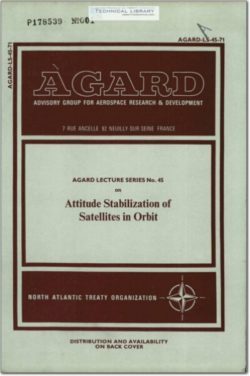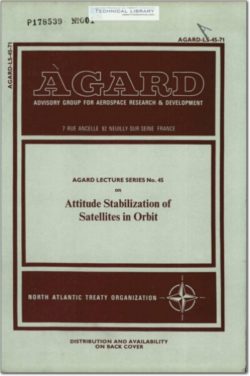AGARD-LS-045-71

- Version
- 187 Downloads
- 34.62 MB File Size
- 1 File Count
- March 9, 2016 Create Date
- March 9, 2016 Last Updated
Attitude Stabilization of Satellites in Orbit

The attitude stabilization of an orbiting satellite is certainly one of the most critical problems
related to satellite design This is an extensive problem, as the missions of space vehicles are diversified,
and attitude accuracy requirements varied. Besides, the procedures adopted between launch phase and final
stabilization are sometimes very complex. Consequently, the disciplines involved are numerous; they call
for the most advanced techniques, and it goes without saying that the scope of the problem had to be Limited
when nine lecture themes had to be selected for a two-day presentation. We first thought of a possible sub-
division between active, passive and semi-active stabilization; however, it appeared that some confusion
existed between these terms, moreover, hybrid solutions were commonly used.
To help the audience to get a clear understanding of the papers presented, we have thought it useful
to start with a survey of the mathematical problems posed by attitude stabilization. This is the theme of
the lecture given by Dr. M. A. FRIK, Professor at the University of Stuttgart. This lecturer reviews various
concepts: Euler's angles and equations, Poinsot's ellipsoid, linearization in the case of small deviations.
The influence of disturbing torques is described and, finally, the motion equations of a flexible satellite
are introduced. This latter part is taken up again in detail by Messrs. Likins and Willems.
Prof. Peter W. LIKl'NS, from the University of California, discusses the influence of the flex-
ibility of a vehicle. Tracing out the history of a few partial failures, he ascribed some stability anomaly
cases to flexibility reflected in the form of dissipated enery or detrimental deformations. Prof. Likins
surveys the present state-of-the-art in this field, stressing the fact that the problems raised are not purely
academic, but, on the contrary, have to be solved for the large satellites of the future.
Prof. P. WIIIEMS, from the University of Louvain, discusses the problem of dual. rotation satellites
in the case of a free space trajectory, as well as in the case of a circular orbit around-the earth;_ he in.-
vestigates equilibrium and stability positions. He discusses the case of a flexible Junction between the
two mobile parts and outlines a strict treatment for this problem.
Mr. W. G. HUGHES, from the Royal Aircraft Establishment (R.A.E.), considers the complete servo-
control loop of an active satellite. He briefly describes the various types of engine torques used. He
derives equations for a system with three inertia wheels and describes the conditions ensuring a slight inter-
coupling between the axes. He presents in detail the single axis case, control by inertia wheel including
desaturation methods, control. moment gyro and control by gas ejection.
| File | Action |
|---|---|
| AGARD-LS-045-71 Attitude Stabilization of Satellites in Orbit.pdf | Download |

Comment On This Post